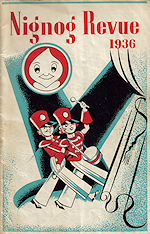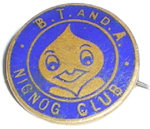The Nignog Club
Feature from 2011

The 1936 Revue

Club badge
It was known as the Nig Nog club, and in these days of political correctness and over eager internet filters, it’s not a phrase you type into Google with care free abandon.
We have often wonder why it was called this, and what it’s origins were. Calls and enquiries to the Telegraph and Argus, where Ernie’s membership was held, also failed to uncover the details we were looking for.
With a brave heart we trawled the internet to try and find any information we could, and try to piece together some kind of article worthy of adding to the site. Fairly quickly, to our amazement, we found it.
The Nig Nog club originated in County Durham and was created by The Northern Echo newspaper. A newspaper that is still going and one of their reporters, Chris Lloyd has kept the memory alive. Using his material by kind permission, and from other sources including The Northern Echo, we at last can finally present the story of the Nig Nog Club.
On 21st October 1929 The Northern Echo launched the Nig-Nog Ring, a children's club, which within three months had 50,000 members - many of whom still have a Nig-Nog Club badge at the bottom of a drawer.
Nig and Nog were “two little imps who live in the land of the moon, their chief occupation being to keep the Man in the Moon awake”. They were occasionally joined in their cartoon adventures by Japhet, but it is difficult to say what kind of creature he was.
The “Chief Ringers” were Uncle Mac and Uncle Ernest. The latter was Ernest Noble, the cartoonist from Darlington, and the former was the BBC broadcaster Derek McCulloch who hosted Children’s Hour on the wireless.
He was a proper bow-tie BBC type who had lost an eye on the Somme and a leg in a motorbike accident. He was the assistant commentator on the first broadcast FA Cup final in 1927 and provided the baa-ing vibrato voice of Larry the Lamb for 30 years.
On joining the club, young Nig Nogs received a blue membership badge and were eligible to apply for offers such as a Brownie camera. Every community had its own Ring where children gathered to be kind to animals and to raise money for charity. Their fund-raising paid for two cots to be endowed in Darlington Memorial Hospital. There used to be a plaque above the cots, but this has long since disappeared. (Maybe something to do with the modern connotations of the name?)
An 80-strong Nignog Troupe toured the Rings with a gangshow entitled Nignogs Ahoy! – “lilting tunes, dainty song, vivacious dances, plenty of fun”.
Other newspapers introduced Nignog Rings. In the Bradford Telegraph and Argus’ Nignog Troupe, Ernest Wiseman made his big stage debut.
The high water mark of Nignogism was May 1933 when a splendid fundraising effort sent hundreds of children from deprived Durham industrial areas to Cober Hill Guesthouse, near Scarborough. Prince George, son of George V, visited the holidaymakers where he was enrolled as an honorary Nignog and given a gold Nignog badge.
Then war clouds gathered. The last Nignog was No 138,057 – Ivor Postgate, from Upsall, Thirsk. On September 1, 1939, the day after he joined, the Nignogs’ space in the newspaper was dramatically cut from half-a-page to a small corner.
On September 2, Nig and Nog did not appear at all, and on September 3, the Nignogs’ childhood was blown apart. War was declared, and the Ring never returned – although it lives on in many people’s memories.
Each new member received their welcome letter....
© morecambeandwise.com 2011